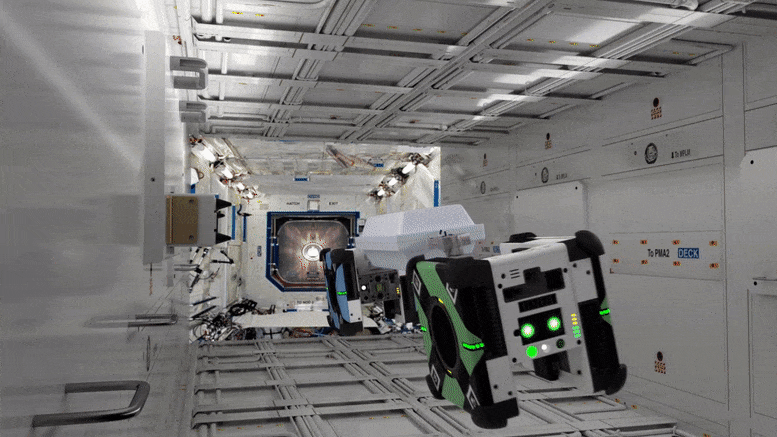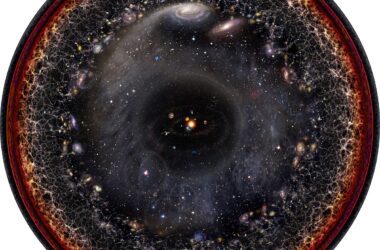
Animation d’Astrobees sur la station spatiale. Crédit : NASA
Il y a trois ans, deux robots ont été lancés sur la Station spatiale internationale (ISS) pour ouvrir la voie à l’avenir de la robotique et des systèmes autonomes dans l’espace. Ces pionniers étaient Honey et Bumble, bientôt rejoints par un troisième compagnon appelé Queen, et ensemble ils constituent le système robotique de vol libre Astrobee. Les robots comme les Astrobee sont des éléments essentiels du ;” data-gt-translate-attributes=”[{” attribute=””>NASA’s Artemis mission to deliver humans back to the Moon, before traveling to Mars and beyond.
“There’s a reason so many science fiction stories have a beloved robot alongside the human heroes – we know we can’t explore space alone,” said Jose Benavides, the Astrobee Facilities Project Manager at NASA’s Ames Research Center in California’s Silicon Valley. “We’re showing that humans and robotic systems can collaborate and support powerful science and engineering beyond Earth.”

NASA astronaut Shane Kimbrough poses aboard the International Space Station with all three Astrobee robotic free-flyers. Credit: NASA/Shane Kimbrough
Since launch, the Astrobee program – run out of NASA Ames – has operated over 750 hours on the space station, completing over 100 activities, from tech demonstrations to assisting in experiments. The robots have proven capable of feats previously in the realm of science fiction, such as detecting an anomaly during a simulation on station (see video below) and connecting autonomously with station subsystems. Honey, Bumble, and Queen have been busy bees, and they show no signs of slowing down.
Le système intégré pour le gardiennage autonome et adaptatif de la NASA, ou ISAAC, fait progresser une nouvelle technologie permettant aux robots de prendre soin des vaisseaux spatiaux. Les chercheurs ont récemment fait la démonstration de cette technologie à bord de la Station spatiale internationale en utilisant Astrobee, les assistants robotiques en vol libre de la NASA. Crédit : NASA/Ames Research Center
Trois ans d’évolution des astrobes
Les Astrobees sont une technologie de nouvelle génération, basée sur trois robots en forme d’orbe du projet SPHERES (Synchronized Position Hold, Engage, Reorient, Experimental Satellite). Les Astrobes ont évolué à partir de ce concept initial au fur et à mesure que les chercheurs développaient de nouveaux outils et de nouvelles capacités.
Vidéo du 1er avril 2018 expliquant comment le projet Astrobee développe un ensemble de trois robots en vol libre qui fonctionneront à l’intérieur de la Station spatiale internationale (ISS) aux côtés des astronautes. Crédit : NASA
Ils volent en microgravité à l’aide de ventilateurs électriques, ils ” voient ” à l’aide de caméras et de capteurs, et ils sont dotés de bras pour tenir des objets ou rester stables pour les tâches nécessitant de la stabilité. Les chercheurs ont également testé un technologie adhésiveLes chercheurs ont également testé une technologie adhésiveinspirée des pattes de gecko, pour permettre aux Astrobes de s’agripper à diverses surfaces sans appliquer de force pour adhérer et se détacher à la demande. Les équipes d’Astrobee envisagent un système robotique suffisamment intelligent et polyvalent pour gérer les tâches d’entretien et de surveillance les plus simples et laisser les astronautes libres de s’attaquer à des tâches plus complexes.
Vidéo de 2019, avant le lancement des Astrobes vers l’ISS. Astrobee est un système de robot en vol libre destiné à la Station spatiale internationale. Conçu et construit au centre de recherche Ames de la NASA, dans la Silicon Valley californienne, ce système sera utilisé pour aider les scientifiques et les ingénieurs à développer et à tester des technologies destinées à être utilisées en apesanteur. Ces robots sont conçus pour assister les astronautes en orbite terrestre et soutenir l’exploration humaine durable vers la Lune, Mars ou d’autres destinations de l’espace lointain. Crédit : NASA/Ames Research Center
Mais la plate-forme Astrobee n’est pas seulement destinée aux astronautes. Grâce au programme annuel Défi de programmation du robot Kibo, exploité aux côtés de la Japan Aerospace Exploration Agency (JAXA) and now in its third year, students from across the world can write code for the Astrobees. The winning teams get to see their programs run on the robots in space. Inspiring the next generation of programmers and engineers is vital as NASA prepares for a future where robotics will play a central role in humanity’s exploration beyond our planet.

NASA astronaut and Expedition 63 Commander Chris Cassidy poses with two Astrobee robotic assistants during visual and navigation tests inside the Kibo laboratory module from JAXA (Japan Aerospace Exploration Agency). Credit: Chris Cassidy / NASA
Robotic Autonomy for Artemis and Beyond

NASA astronaut and Expedition 65 Flight Engineer Megan McArthur observes Astrobee robot Honey during an experiment testing its ability to “listen” to station components to help detect anomalies in spacecraft systems that may need servicing. Credit: NASA
Unlike the space station, future deep space outposts may not be crewed year-round, and will need autonomous systems to remain operational. That includes Gateway, which will orbit the Moon and serve as a launching-point for missions to Mars.
The Integrated System for Autonomous and Adaptive Caretaking project (ISAAC) aims to test how robotic systems can complete tasks like repairs, maintenance, and even experiments independently.
By giving Honey and Bumble challenges to solve on their own – like removing a “sock” blocking an air vent – ISAAC is building capabilities needed for robots to take care of spacecraft when astronauts aren’t aboard. But a major component of autonomously operating in a complex environment is being able to have a detailed map and know where you are.
ISAAC’s two most recent demonstrations used Astrobees to create 3D maps of the space station’s interior. Bumble flew out of its home module and mapped out a new environment on its own. The ability to explore and map independently is essential to the future of autonomous robotics.
“Three years ago, we wanted to test out how robotics could support human space exploration, not just for this decade, but for the next several decades,” said ISAAC deputy project manager Maria Bualat at Ames. “We’re starting to see what that’ll look like.”
Astrobee and ISAAC were funded by NASA’s Game Changing Development Program, part of the Space Technology Mission Directorate.


